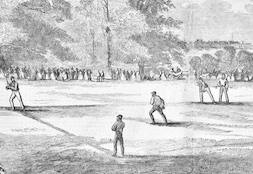
During the 1850s, the open spaces offered by New Jersey’s waterfront cities lured baseball clubs from increasingly crowded Manhattan. The ability to cross the Hudson River quickly, safely and cheaply made Hoboken and, to a lesser degree, Jersey City prime sporting destinations for New York City ball players. This triggered an explosion of interest in the game among native New Jerseyans. By the end of the 1850s, dozens of clubs had formed in the towns of Hudson and Essex counties.
Jersey City in the pre-Civil War era was what might be regarded today as an early suburb of New York. Young professionals who worked in Manhattan took a ferry to work each morning and returned in the early evening. These individuals were exposed to baseball in New York, and eventually brought it back home and formed their own clubs. Eventually, almost every neighborhood in Jersey City had a team—typically made up of young men in various white-collar trades, as well as craftsmen and members of fire companies. Many clubs involved a social component, with members also gathering for parties or family outings.
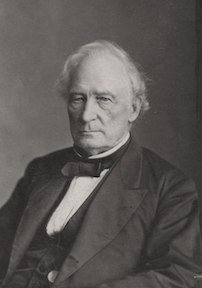
In 1855, two Jersey City contingents joined the five clubs already playing regular games at Hoboken’s Elysian Fields: the Pioneer Base Ball Club and the Excelsior Club. They faced each other for the first time that summer in a doubleheader. In the crowd were members of clubs from Manhattan and Brooklyn, no doubt sizing up their future competition. The Excelsiors won both games. A return engagement a week later at a field laid out in Hamilton Square appears to mark the first time an organized game was played within Jersey City limits. Although the Pioneers lost this meeting, too, they went on to defeat Brooklyn teams at home and away in September. The Pioneers’ catcher was Dudley Gregory Jr., the son of the city’s mayor (left).
Unfortunately, the following year, both clubs lost their “home” grounds to development. Jersey City’s top players were lured away by more-established clubs across the Hudson and each disbanded before the 1857 season—a season that saw an explosion of interest in the game.
Clubs continued to form in Jersey City into the 1860s. The Civil War drained much of the manpower, but “junior” clubs—made up of teenagers—continued to thrive during this time. The best of the bunch was the Champion Club, which formed in 1863. The Champions were too young to be members of the newly formed National Association of Base Ball Players, but they defeated NABBP teams, including the Elizabeth Resolutes, one of the state’s top clubs. The Champions had winning records every year from 1863 to 1866, and eventually were admitted into the NABBP in 1867. That season they drew a record crowd for their game against the visiting New York Mutuals, one of the nation’s outstanding nines.
Based on the Champions’ success, they were furnished with a fancy new park in 1868, which included a grandstand and large changing rooms. They enjoyed another fine season, including a win over the powerhouse New York Eagle Club, which had previously poached some of Jersey City’s better players. The Champions lived up their name, sporting the only winning record against top-flight competition among New Jersey baseball clubs that year. William Willis, a pitcher who joined the club in 1864, was considered their best player.
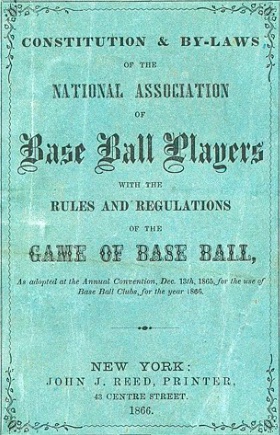
The Champions scheduled a series with the Resolutes the following summer to determine baseball supremacy in New Jersey. The Champions won the first game and led the second when rain ended the contest. That fall, the Champions played a best-of-three series against the Brooklyn Star Club, which was billed as the amateur championship of the United States. They lost 2 games to 1, but suffered only three defeats in total during 1869 and, again, had the best record among all New Jersey NABBP clubs at 17–3.
In 1870, several Champion club members went to see a game in Jersey City between two other teams—who didn’t show. The Champions formed a team to play against another nine that was made up of white and black ball players. The local paper was highly critical of the Champions for sharing the field with people of color. The historic nature of this integrated contest was not even mentioned. The Champions continued to play good ball in 1871 but, by the end of the 1872 season, the once-young players’ interest had waned and the club disbanded.
The 1870s marked a critical change in the way baseball was organized. During the previous decade, it was not unusual for clubs to compensate some of their best players, or to lure stars away from other clubs with the promise of a no-show job or a lucrative payday. This undermined nines such as the Champions, who sought to maintain their social component and amateur status. In 1871, the distinction between amateurs and professionals was memorialized by the formation of the National Association of Professional Base Ball Players—a group of 10 clubs that set themselves apart from the NABBP. Amateur teams continued to play in Jersey City, and baseball continued to build in popularity, but the business of baseball had arrived and the succeeding chapters of the sport in the city would be played out on a pay-for-play basis.
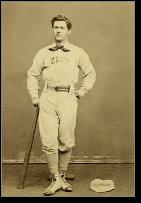
In 1884, the 11-team Eastern League began play. The quality of play was good; most teams contained at least a half-dozen former or future major leaguers. The Eastern League functioned as an independent entity, selling tickets and—hopefully—selling players to teams in the National League and American Association. In 1885, the Jersey City Skeeters joined the league. The team’s name was inspired by the bugs that plagued visitors to the as-yet-undrained marsh areas on the city’s fringes. The Skeeters’ most notable players in their inaugural season were Bill Schriver and Tim Murnane (left). Murnane, a slick-fielding outfielder, had been a fixture in professional ball since the early 1870s, and would soon become one of the game’s most heralded sportswriters. Schriver, a teenaged catcher in 1885, was still playing professionally more than 20 years later, at which point he was known as “Pop.”He was the first player to attempt to catch a ball tossed from the top of the Washington Monument. Unfortunately, the Skeeters failed to make a go of it and disbanded early in the summer.
Into the breech stepped another Jersey City club, the Jerseys. This group, managed by future league president Pat Powers, boasted a couple of future stars in young Mike Tiernan and Juice Latham, a veteran slugger. The team had called Trenton home the year before. The Jerseys moved to the International Association in 1887, the Central League in 1888, and the Atlantic Association in 1889—playing all three seasons as the “Skeeters.” From 1891 to 1899, the best ball played in Jersey City was at the semipro level, as the city did not field a minor-league club.
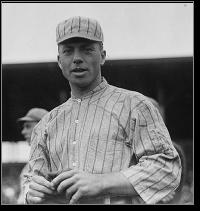
In 1902, Jersey City fielded a new Skeeters club in the new Eastern League, which had re-formed seven years earlier. The team was anchored by old-timers Jocko Halligan, Billy Shindle and Cupid Childs. The team enjoyed enough success at the gate to tempt Moose McCormick (left) away from Bucknell in 1903. McCormick was one of the nation’s top college football stars. The Skeeters won their lone pennant that year. Several Jersey City players were featured on baseball cards a few years later, in the 1909–11 period.
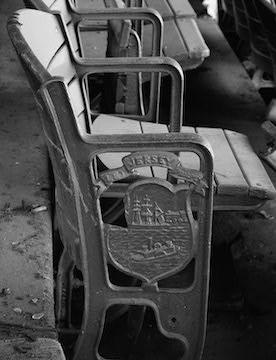
The Skeeters moved to the International League in 1912 after the Eastern League disbanded. The Skeeters played in the IL from 1912 to 1945. The city did not field a team in 1916 and 1917 and from 1933 to 1936. In 1932, the Skeeters functioned as a farm team of the Brooklyn Dodgers. They had the same relationship with the Giants starting 1937, and were informally known as the “Little Giants.” The team moved into brand new Roosevelt Stadium (right) in 1937 and the ballpark also hosted several major-league games in the years that followed.
Many star players came through the Skeeter/Little Giant clubhouse. Among those on their way up to big-league stardom were Dolf Luque, Jimmy Ring, Billy Urbanski, Billy Rogell, George Selkirk, Johnny Allen, Dixie Walker, Jo Jo Moore, Hank Leiber, Sid Gordon, Mickey Vernon, Buddy Kerr, Sal Maglie, Don Mueller, Sol Rogovin, Billy Gardner and Whitey Lockman—who was just 16 when he first donned the Jersey City uniform.
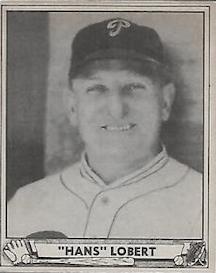
Among the stars who played for the club on the way down were Mike Donlin, Duffy Lewis, Bobby Veach, Joe Dugan, Highpockets Kelly, Charlie Jamieson, Babe Herman and Tony Cuccinello. Some of baseball biggest names also managed Jersey City, including Hooks Wiltse, Wild Bill Donovan, Joe Tinker, Bob Shawkey, Hans Lobert (left), Travis Jackson and Gabby Hartnett. Bert Niehoff managed the club to the International League pennant in 1939. The team won another pennant in 1947 under Bruno Betzel.
In 1951, with sagging attendance eating into the club’s profits, the Giants moved the franchise to Ottawa. The last great player to wear the team’s uniform was Monte Irvin, who played for Jersey City for parts of the 1949 and 1950 seasons.
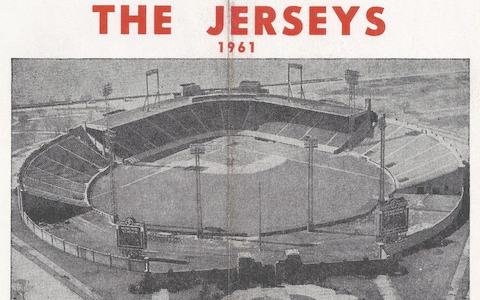
Minor-league baseball in Jersey City got an unexpected reprieve in 1960 thanks to the Cuban Revolution. The Cincinnati Reds had to move their farm team in Havana, and Roosevelt Stadium proved to be a good temporary home. In 1960 and 1961, the “Jerseys” featured several exciting future major leaguers, including Chico Cardenas, Vic Davalillo, Mike Cuellar, Joe Azcue and Cookie Rojas. In 1962, the Indians purchased the Jerseys and moved them to Jacksonville, Florida, where, as the Suns, they later became a farm team for the Mets.
Jersey City’s last hurrah came in the late-1970s, when the Indians had a farm team there in 1977 and the A’s had one in 1978. The 1977 club was managed by New Jerseyan Johnny Orsino. Pitchers Jim Clancy and Mike Norris were the most notable players to wear the JC uniform the 1970s.
Jersey City League Leaders
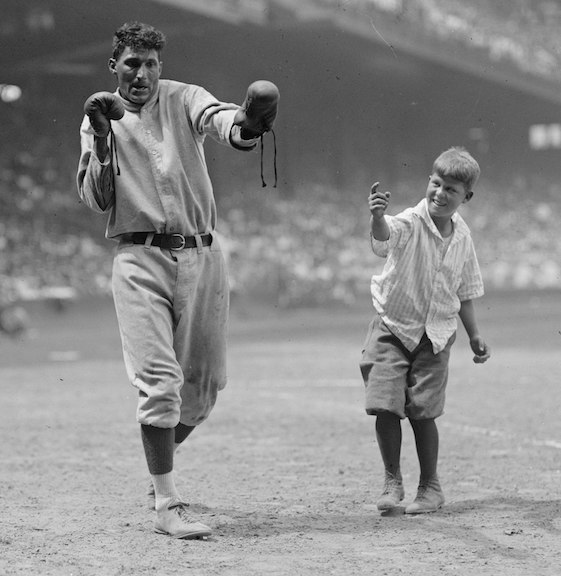
1919 • Al Schacht (right) • 9 Shutouts
1921 • Frank Kane • 68 Stolen bases
1923 • Joe Lucey • 2.73 ERA
1928 • Jess Bream • 2.32 ERA
1937 • Ben Cantwell • 1.65 ERA
1938 • George Myatt • 45 Stolen Bases
1938 • Rollie Stiles • 5 Shutouts
1939 • Johnny Dickshot • .355 Batting Average
1939 • Roy Joiner • 2.53 ERA
1942 • Bobby Coombs • 1.99 ERA
1943 • Lou Polli • 1.85 ERA